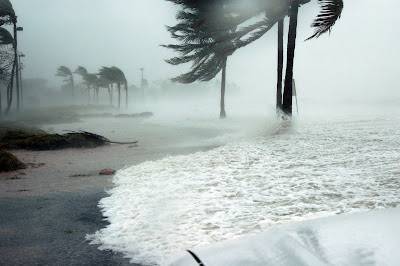Hurricanes are feared for their lashing winds, torrential rains and storm surges. These are one of the strongest and most dangerous natural calamities on Earth because they can leave great damage.
Hurricanes are part of the tropical family. They usually occur in the North Atlantic Ocean and in the easternmost parts of the Northeast and South Pacific Ocean. Another natural disaster and the sister of a hurricane is called a typhoon. Typhoons occur in the Northwest Pacific Ocean, the west part of the dateline. If you live near the coastal areas, you'd most likely be affected by hurricanes since they pose the greatest threat to residents living in that area.
The extent of a hurricane’s destruction comes from the intensity of the storm. A number of factors include the effectiveness of advance warnings and the presence of defensive structures like seawalls and mangroves.
Listed below are essential preparatory steps during the hurricane season.
· Store an adequate supply of food and clean water. These are most needed when the hurricane comes because we don’t know when the hurricane will stop. Supplying enough food and clean water will help you survive.
· Prepare ready-to-eat food; this includes canned food.
· Keep flashlights, candles, and battery-powered radios. Preparing them will give you light and communication to the authorities for warning and emergency purposes.
· Check your house and repair weak and unstable parts.
· Be updated with the latest weather report.
· If you have pets, secure them in a safe place.
· If you are leaving near a coastal area, place your boats in a safe area.
· If you need to evacuate, prepare lots of clothes, a first aid kit, candles/ flashlights, battery-operated radios, food, etc.
Public safety officials use prompt and dependable systems to give you alertness in the event of natural disasters like hurricanes. During an emergency, vigilant and punctual officials give the public life-saving information quickly. Through the Integrated Public Alert and Warning System (IPAWS) infrastructure, the Wireless Emergency Alerts or WEAs is made available. A Wireless Emergency Alert is one of the ways that public officials can give fast responses to alerts and warnings to the public about serious emergencies.
What are Wireless Emergency Alerts or WEAs?
· WEAs can be given by the state and local public safety officials, the National Weather Service, the National Center for Missing and Exploited Children and the President of the United States.
· They can also be used and issued for three vigilant categories: AMBER, imminent warning, and presidential.
· WEAs look like text messages but are uniquely created to get your attention and give you alertness with a distinctive sound and vibration.
· WEAs only have 90 characters which includes the type and time of alert and any given action that should be taken.
· There will be no charges for mobile users and subscription is not needed.
· Check with your service provider to ensure that your device is WEAs-capable.
Emergency Alert System
· The Integrated Public Alerts and Warning System or IPAWSA is a modernization and integration of the nation’s existing and future alert warning systems, infrastructure and technology.
· The EAS or Emergency Alert System is a national public warning system that demands broadcasters and other digital audio services to give the President the capability to communicate in addressing the people within 10 minutes during a national emergency.
· It can also be used by state and local authorities to bring important emergency information like weather threats, AMBER alerts and local incident information targeted to some areas.
NOAA Weather Radio All Hazards or NWR is a nationwide network of radio stations that broadcasts continuous weather information from the nearest National Weather Service office. It gives warnings, forecasts and other hazard information for 24 hours a day, 7 days a week. Through the Emergency Alert System, it broadcasts alerts of non-weather emergencies like national environment and public safety and national security.
Hurricanes and other natural disasters do not give you enough time to prepare. They cause serious damages that can baffle any home owner or establishment. The experienced team at ServiceMaster by PWF can assist you with all detailed restoration. We at ServiceMaster by PWF are servicing for water damage restoration services in Jacksonville and other parts of Duval County. Contact our office at (866) 599-0871.
SUMMARY
We all know that a hurricane is a hazardous calamity brought by nature. It gives sever effects to people, homes, and infrastructure. It is feared for bringing slashing winds and heavy rains and it can also cause floods. Some people don’t know what to do before, during and after a hurricane lashes on. You need to gather information. You must know where the nearest evacuation center is in your area. Listen to weather forecasts and understand the meaning of emergency alerts and warnings. Keep a list of contact information for reference.
Plan and take some action. Everyone needs to be prepared when a weather disturbance is on high. Like they say, expect the unexpected. Prepare emergency supplies like adequate food and clean water, clothing, first aid kits, battery-operated radios, wireless phones, extra chargers and batteries, flashlights, candles and matches. Have your emergency plans at the ready. Learn and apply the emergency alert systems like the WEAs or Wireless Emergency Alerts. They can protect you and your family from natural disasters. Applying these emergency and warning alert systems makes the public prompt and vigilant to hurricanes and other calamities caused by nature.
If affected, at least you can recover easily from the huge damage caused by the calamity because you have applied the emergency and warning alert system.
Before going back to your location that the hurricane has affected, wait for the declaration that the area is safe and remember that recovering from a disaster takes a little longer to process.

No comments:
Post a Comment